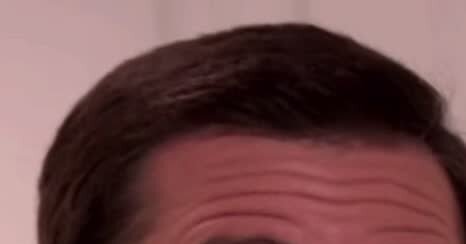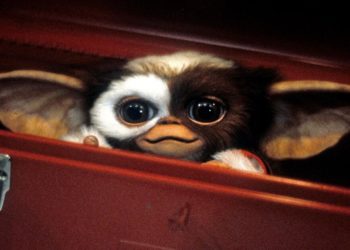It was mostly lost amid the free-speech concerns and subscription cancellations, but one of the stranger sidelights of the benching of Jimmy Kimmel came in the form of a meme from “The Office.”
In September, the media-industry reporter Brian Stelter asked Brendan Carr, the Federal Communications Commission chair, for comment on the suspension of the talk-show host. Carr had criticized Kimmel for his comments in the aftermath of Charlie Kirk’s assassination, suggesting that ABC affiliates should take action; they did, after which the network (temporarily) pulled “Jimmy Kimmel Live!”
Carr answered with a GIF, showing Michael Scott (Steve Carell) and Dwight Schrute (Rainn Wilson) of “The Office” celebrating with a “raise the roof” gesture:
This was not exactly a standard format for official comment, nor did it mesh with Carr’s later denial that he was trying to get Kimmel pulled from the air. It was also a curious choice, for a bureaucrat accused of heavy-handed censorship, to send a response associating himself with one of TV’s most famous inept bosses and his officious, power-tripping lackey. (Though Carr’s vague threat over Kimmel, “We can do this the easy way or the hard way,” did sound like something Dwight would have written in a testy memo about fire-safety procedures.)
But this proclamation-by-meme was fitting for an administration that increasingly communicates through online-trolling imagery. And it underscored a digital-culture phenomenon: Over a decade since it went off the air, “The Office” has become the lingua franca of the social internet.
Michael Scott and his rubber-faced expressions have provided an entire emotional vocabulary for tweets and replies. When I enter an emotion into the search bar of my text app’s image finder — “delight,” “anger” — there he is. (“No! God! Please! No!”)
Meme templates, like Jim Halpert (John Krasinski) pointing at a whiteboard or Pam Beesly (Jenna Fischer) saying that two images are the same picture, have become carriers for dad jokes and political commentary. Stanley Hudson (Leslie David Baker) has been enlisted to roll his eyes at every form of foolishness humans can commit.
Of course, it’s not surprising that a screen-based culture, after nearly a century of TV programming, should have a vast library of video references to use as metaphors. As Neil Postman wrote in “Amusing Ourselves to Death” decades before the heyday of the reaction GIF, “Television is our culture’s principal mode of knowing about itself.”
But there’s something special about “The Office,” which achieved a social-comments footprint unmatched by sitcoms, like “Seinfeld,” that had far bigger audiences in their own time. It’s easy to forget, but for most of its run on NBC, “The Office” was a modest hit at best.
“The Office” may have had timing on its side. Yes, it aired in a period (2005–13) when network audiences had been diminished by competition from cable. But it enjoyed an even larger afterlife through reruns on streaming, particularly during the isolation of Covid, when what began as a tart sendup of dull corporate life became a warm reminder of in-person experiences.
What’s more, its run coincided with the growth and dominance of social media, when fans had the means to digitize and share images easily. As long as there’s been TV, people have quoted shows to make social connections. This may be one reason for the popularity of catchphrases in sitcoms of the 1970s and 1980s; when my grade-school friends and I told each other “Up your nose with a rubber hose,” we were doing viral marketing for “Welcome Back, Kotter.” But the ubiquity of devices and image searches made the process, like so much else, more friction-free and pervasive.
Why this sitcom of the aughts and not so many others? One factor, surely, is the format. “The Office,” like its British predecessor, is a mockumentary, meaning that its characters were aware of a camera and would overtly address, even perform for it. They see you and acknowledge you; they are playing to an audience.
This makes them the perfect vehicle for reaction, from affirmation …
to encouragement …
to disdain:
Jim’s smirking at the camera, for instance, is the gesture of a co-conspirator. He’s bringing you in on the joke, asking “You and I both see how dumb this is, right?”
The expression became so widely shared that viewers of the 2024 vice-presidential debate thought that the extremely-online JD Vance was echoing it on purpose. (He later said the resemblance was a coincidence.)
Non-mockumentary comedy, like most staged performance, operates on the assumption that you are surreptitiously watching the characters, who expose themselves inadvertently. But the characters in “The Office” are trying to express themselves to a camera they know is there, meaning they created thousands of tiny expressions to repurpose.
The Jim whiteboard meme, for instance, came from a scene in which he makes a diagram to illustrate Michael’s delusion that he will be related to a baby his ex-girlfriend is having using a sperm donor. Recaptioned as the “Jim Halpert Explains” meme, it becomes a kind of virtual poster board or blank greeting card. Often, it’s used to dunk on all those other idiots who are wrong about religion or taxation or the difference between “there” and “their.” It’s almost like putting on a costume; you’re positioning yourself as Jim, the merry, smug prankster taking the air out of your puffed-up targets.
Conversely, the show’s premise means that the “documentary crew” are working to capture the characters in revealing situations. That gives the images a meme-friendly intimacy, as the camera chases, swivels and pushes in on characters to zero in on key expressions of cringe:
The beauty of “The Office” having become such a mainstay of internet culture is that the show itself was in many ways a product of internet culture. It began the same year YouTube did and often based stories on characters imitating viral videos, whether it was Michael getting into parkour or the cast imitating an internet-famous wedding dance:
“The Office” was such a creature of online content that it became our online language. The show understood that internet humor is now the lowest-common-denominator form of “fun” expression in communal work spaces, much as sitcom catchphrases or Johnny Carson jokes once were. If Michael Scott were real and working today, he would undoubtedly be flooding the Dunder Mifflin Slack with Michael Scott memes.
As it turns out, we all have a little Michael Scott in us.
James Poniewozik is the chief TV critic for The Times. He writes reviews and essays with an emphasis on television as it reflects a changing culture and politics.
The post How ‘The Office’ Memes Became the Language of the Internet appeared first on New York Times.




